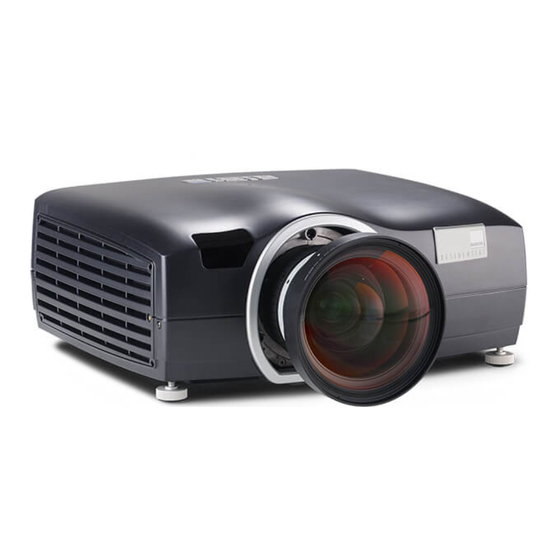
Table of Contents
Advertisement
Advertisement
Table of Contents

Summarization of Contents
Introduction
Overview
Overview of the Orion series projectors, highlighting their high performance features for multi-channel visualization.
Training
Information on training availability at Barco University for projector use, setup, and configuration.
Symbols Used in Documentation
Explanation of warning, note, and tip symbols used throughout the user manual.
Safety and Compliance
General Safety Considerations
Essential safety guidelines for using the projector, covering power, handling, ventilation, and placement.
Mercury Vapor Health Warning
Information and warnings regarding potential health risks associated with mercury vapor from projector lamps.
FCC Compliance
Details on FCC regulations and compliance statements for digital devices, including interference limits.
Disposal Information
Guidelines for proper disposal of the projector and its components, including WEEE and battery directives.
Service and Maintenance
Information on product service, user-serviceable parts, and contacting support for issues.
Light Beam Hazard Distance
Explanation of light beam hazard distance and its implications for projector installation safety.
Hazard Distance vs. Throw Ratio
Details on how hazard distance is affected by the lens throw ratio, with graphical representation.
Installation
System Considerations
Key factors and requirements for a successful projector system installation, including component compatibility.
Ventilation Requirements
Guidelines on airflow and minimum distances required for proper projector ventilation and cooling.
Ceiling and Rig Mounting
Instructions for securely mounting the projector using ceiling or rig mounts and appropriate screws.
Projector Locking
Information on how to physically lock the projector using a Kensington lock for security.
Projector Angle and Tilt
Guidance on the allowed projector tilt angles and the impact on lamp life and overheating.
Selecting and Installing a Lens
Instructions on how to select and install projector lenses using the bayonet mount system.
Lens Lock Feature
Description of the lens lock feature used to fix zoom, focus, and iris positions.
Lens Shift Operation
Details on motorized lens shift for horizontal and vertical image adjustment.
Lens Planarity (Scheimpflug Adjustment)
Information on the rare Scheimpflug adjustment for lens planarity, requiring technical expertise.
Zoom, Focus, and Iris Adjustment
Manual adjustment of zoom, focus, and iris rings for image size, sharpness, and contrast.
Making Connections
Guidance on connecting signal and control cables to the projector's various interfaces.
Connecting Video and Data Sources
Advice on connecting video and data sources, preferring digital interfaces and parallel connections.
Connecting Control Interfaces
Procedure for connecting control interfaces for system integration and management.
Source Format Integrity (EDID)
Ensuring EDID information is not lost in translation to maintain correct image resolution and aspect ratio.
Image Size Charts
Charts illustrating image height, width, and screen diagonal based on projection distance and lens type.
Product Overview
Keypad and Indicator Lights
Description of the projector's keypad layout, button functions, and status indicator light meanings.
Wireless Remote Control
Details on the functions of buttons on the wireless remote control for operating the projector.
Connectors and Ports
Overview of signal and control connectors available on the projector for various inputs and outputs.
Menu System Navigation
Explanation of how to access and navigate the projector's on-screen menu system.
3D Menu Functions
Settings related to 3D functionality, including setup, dual head, and glass synchronization.
Picture Settings Menu
Detailed adjustments for image parameters such as profile, gamma, brightness, contrast, and saturation.
Installation Menu Options
Configuration options for image orientation, source scan, OSD behavior, test images, and synchronization.
Settings Menu
Access to settings like PIN code, network configuration, factory reset, and standby modes.
Language Settings
Selection of the desired menu language from a list of supported languages.
Status Information
Display of system status, source information, synchronization status, and lamp status.
Functionality
Powering On and Off
Instructions for switching the projector on, off, and managing standby modes.
Image Alignment
Using built-in test images for projector alignment, including zoom, focus, and lens shift.
Language Selection
Details on how to change the menu system language.
System Status Monitoring
Accessing system status information like part number, serial number, and active source.
Lamp Power Adjustment
Adjusting lamp power levels for brightness, lamp life, and energy saving.
Source Selection and Scan
Methods for selecting input sources and enabling automatic source scanning.
On-Screen Display (OSD) Messages
Configuration of OSD messages, including enabling/disabling and setting timeouts.
Picture by Picture (PbP)
Functionality for viewing two sources simultaneously side-by-side or top-and-bottom.
PIN Code Security
Setting up and managing the PIN code for projector access control.
Disabling IR Receivers
Instructions for disabling the front and rear IR receivers for the wireless remote control.
Software Upgrades
Procedure for upgrading the projector software using a USB memory stick.
Optimizing Image Quality
Calibration Data and RealColor
Updating RealColor calibration data and using test patterns for accurate color measurements.
Setting White Point and Color Temperature
Adjusting color temperature and white point settings to achieve desired color accuracy.
Gamma Curve Settings
Explanation of gamma curves and their impact on image contrast and tonality.


Need help?
Do you have a question about the Orion Cinemascope and is the answer not in the manual?
Questions and answers